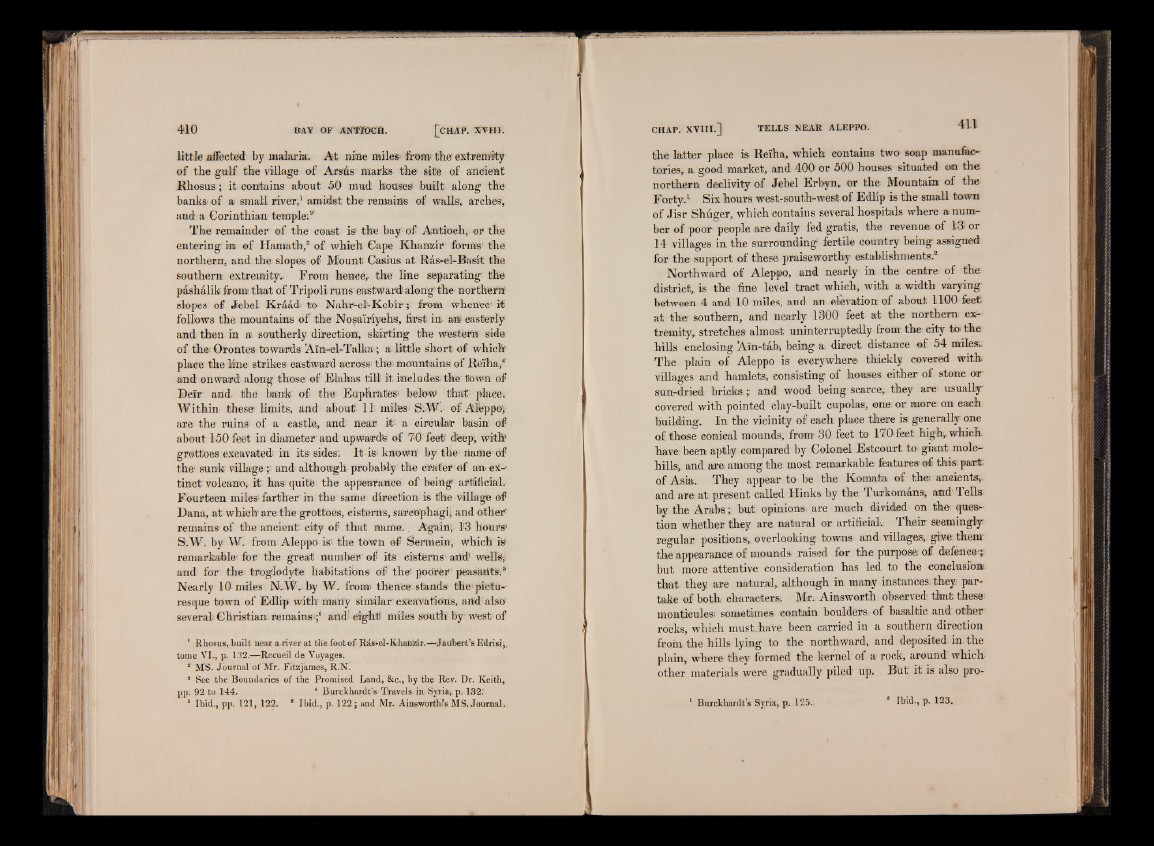
little aiiected by malaria. At nine miles- from; the? extremity
of the gulf the village of Arsiis- marks the; site of ancient
Rhosus; it contains about. 50 mud' houses built along the
banks of a small river,1 amidst the remains o# Walls* arches,
and a Corinthian temple;2'
The remainder of the coast is the bay of Antioch* ©r the
entering in of Hamath,3 of which Cape Khanscir forms' the
northern, and the slopes of Mount Casius at Ras-el-Basit the
southern extremity.. From hence,- the line separating' the
pdshalik from that of Tripoli runs' eastward; along the northern?
slopes of Jebel Kraadi to Nahr-el-Kebirfrom whence' if
follows the mountains of the Nosairiyeh/S, first in. an? easterly
and then in ai southerly direction, skirting the western side
of the; Orontes towards Aln-el-Talka-; a little short of which’
place the lane strikes eastward across the; mountains of Relha*4
and onward along those; of Elakas till it includes; the; town of
Heir and. the bank of the Euphrates; below thaf place;
Within these limits, and about 11 mites* S:-W.- of A-feppo*
are the ruins of a castle, and: near i t a circular basin5 of
about 150 feet in diameter and upwards of 70 feet dfeep* with’
grottoes excavated; in its sides'. It is; known by the name of
the sunk village ;; and although probably the crater of an. extinct
volcano* it has quite the appearance of being artificial;
Fourteen miles farther in the same direction is the village of
Hana, at which'are the grottoes, cisterns, sarcophagi; and other
remains of the ancient- city of that name.. Again;-1?3 hours*
S.W. by W. from Aleppo is; the town of Sermein, which is
remarkable'for the great number of its cisterns and’ wells*
and for the; troglodyte habitations of the; poorer peasants;8
Nearly 10 miles N.W.-by W. from; thence stands ifiiC'picturesque
town of Edlip with- many similar'excavations, and’also
several; Christian; remains-;6 and* eight! miles south by west of
1 Rhosus, built near a-riverat the foot of R4s*-el-K.haffizir.—Jailbert’s Edrisi*.
tome VI., p. 132.—Recueil de Voyages.
2 MS. Journal of Mr. Fitzjames, R.N.
3 See the Boundaries of the Promised Land, &c., by the Rev. Dr. Keith,
pp. 92 to 144. 4 Burckhardt's Travels- in: Syria, p. 1-32.'
5 Ibid., pp. 121, 122. 8 Ibid., p. 122; and Mr. Ainsworth’s MS. Journal.
the latter place is Reiha, which contains two soap manufactories,
a good market, and 400 or 500 houses situated on the
northern declivity of Jebel Erbyn, or the Mountain of the
Forty.1 Six hours west-south-west of Edlip is the small town
of Jisr Shuger, which contains several hospitals where »number
of poor people are daily fed gratis, the revenue of 13i or
14 villages in the surrounding fertile country being assigned
for the support of these praiseworthy establishments/
Northward of Aleppo, and nearly in the centre of the
district is the fine level tract which, with a width varying
between 4 and 10 miles, and an elevation of about 1100' feet
at ther southern, and nearly 130Q feet at the northern; extremity,
stretches almost uninterruptedly from the eity to the
hills enclosing Ain-tab* being a direct- distance of 54 miles..
The plain of Aleppo is everywhere, thickly covered with
villages and hamlets, consisting of houses either of stone or
sun-dried bricks ; and wood being scarce,, they are; usually
covered with pointed clay-built cupolas, one or more; on. each
building. In the vicinity of each place there is generally one
of those conical mounds, from 30 feet to 170-feet high,, which
have; been aptly compared by Colonel Estcourt to giant molehills,
and aare among the most remarkable features- of thas; part;
of Asia. They appear to be the Komata of the: ancients;,
and are at, present called Hinks by the Turkomans, and Tells,
by the A rab sb u t opinion«, are much divided on the quest-
tion whether they are natural or artificial., Their seemingly,
regular positions, overlooking towns and villages*, give them
the appearance of mounds raised for the purpose of defence;;;
hut more attentive consideration has led to the conclusion*
that they are natural,, although in many instances they partake
of both characters* Mr. Ainsworth observed that these;
monticules; sometimes) contain boulders of basaltic and other
rocks, which must,have been carried in a southern direction
from the hills lying to the northward, and deposited in, the
plain* where they formed the kernel of a- rock, around which.
other materials were gradually piled' up. But it is also pro-
1 Burckhardt’s Syria, p. 125. 2 Ibid., p. 123.